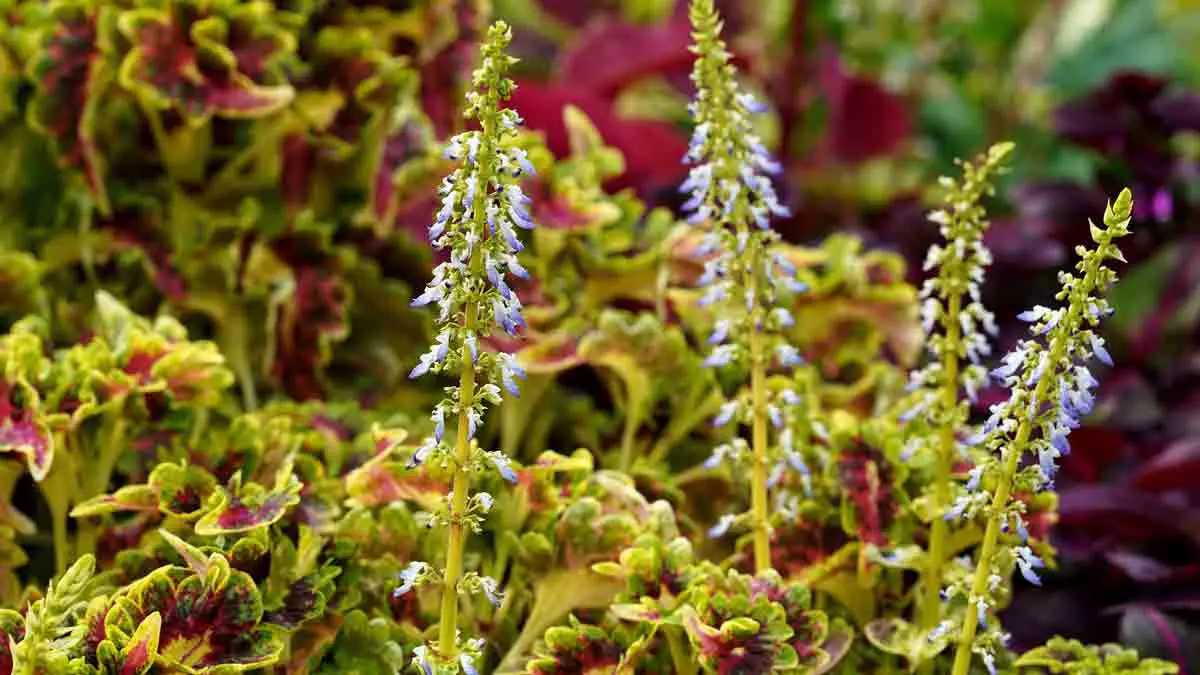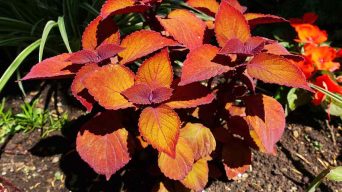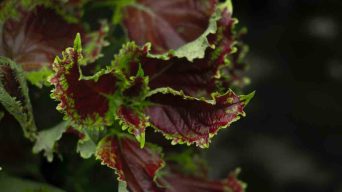Coleus plants do have flowers, which usually appear in late summer. However, the flowers can be removed if desired by pinching or cutting them off to maintain the plant’s focus on producing foliage. If left to bloom and go to seed, the plant will reach the end of its lifespan and die.
Coleus plants have long been prized for their colorful foliage.
But do coleus flower?
The answer is yes, but managing blooms on your plant can be tricky. While the flowers may add a splash of color to your garden, they can also detract from the beauty of its leaves.
In this article, we’ll explore why and how coleus plants bloom and give tips on dealing with them if you don’t want blooms in your garden.
Do Coleus Plants Have Flowers?
Do you love the look of colorful foliage in your garden? If so, then you should consider adding Coleus plants to your landscape.
Coleus plants are a popular choice for gardeners because they provide vibrant colors and interesting shapes that can brighten up any garden corner.
But do Coleus plants have flowers?
The answer is yes! Coleus plants produce small blue or white flowers that appear in late summer or early fall.
However, these flowers are not particularly showy and can be easily overlooked. The main attraction of Coleus plants is their beautiful foliage, which comes in various colors and patterns.
While the flowers may not be as eye-catching as the foliage, it’s important to remember that they still serve an important purpose: providing nectar for pollinators like bees and butterflies.
Allowing some flowers to form at the end of the season will help attract beneficial insects to your garden.
Flowers also help Coleus plants reproduce. These flowers will ultimately form seed pods, which can be collected and replanted in your garden or shared with friends.
Why Do Coleus Flower?
Coleus flowering begins as a signal that winter is coming, and the plant should produce seed to continue its genetic dynasty.
Several factors, including the age of the plant, stress, variety, day length, and cool nights trigger flowering in coleus plants.
1. Age of the Plant
The age of a coleus plant can be an important factor in whether or not it will flower.
Plants kept over from year to year are more likely to flower than younger ones.
This is because older plants have had more time to mature and build up energy reserves that will help them survive through winter.
2. Stress
Stress can also cause coleus plants to flower.
If a coleus plant is exposed to too much heat or cold, or it’s not getting enough water or nutrients, it may start producing flowers to conserve energy and resources.
3. Coleus Variety
The variety of coleus you choose can also affect whether or not it will flower.
Some varieties are bred specifically for their foliage and won’t flower at all, while others may be more prone to flowering due to their genetics.
4. Day Length
Day length is another factor influencing whether or not your coleus will flower.
As days get shorter in autumn, some varieties of coleus may start producing flowers in response to the changing light levels.
5. Cool Nights
Cooler nights in autumn can also trigger flowering in some varieties of coleus plants.
The cooler temperatures signal that winter is coming and encourage the plant to produce flowers to set seed before the cold weather arrives.
So if you’re looking for colorful foliage without any flowers, make sure you choose a variety that’s less likely to bloom and keep an eye on environmental conditions like temperature and day length, so your coleus stays healthy and blooms-free!
Should You Let Coleus Plants Flower?
For gardeners looking to add a bit of extra color and interest to their gardens, the temptation to let coleus flower like crazy each year is often too great to ignore.
But should you actually let your coleus flower, or should you pinch back the stems before they go to seed?
There are a few benefits to allowing your coleus plants to flower.
Letting them bloom can be a great way to add some extra color and interest to your garden without worrying about pinching back the flower stems every few weeks.
It can also give your garden a wilder and more natural look, making it more attractive for passing wildlife like birds and butterflies.
Additionally, since coleus typically blooms in late summer or early fall, it can be the perfect addition for adding a splash of color as autumn approaches!
On the other hand, some drawbacks come with choosing to let your coleus flower.
For example, when left alone, they will eventually set seed which could potentially spread throughout your garden and create an unintentional “weed” problem.
In addition, flowering can take away from energy reserves which could slow down growth and lead to a less healthy plant.
Ultimately, deciding whether or not you should let your coleus have free reign over its flowering abilities is totally up to you!
Just remember that if you decide not to allow them any bloom time this season, there’s always next year when another round of vibrant colors awaits!
What to Do with Coleus Blooms
Coleus plants are popular for their colorful foliage, but you may be surprised to learn that they also produce blooms.
Coleus flowers are generally small, blue, white, and tube-shaped, growing in dense clusters on the ends of the stems.
Knowing what to do with the blooms can help you keep your coleus looking its best.
Pinching off the Spikes
The simplest way to manage coleus blooms is by pinching off the flower spikes as soon as they appear. This helps prevent the plant from expending energy on producing seeds.
Pinching or cutting off the coleus flowers also helps direct more of the plant’s energy into growth and foliage production.
Letting the Blooms Grow and Produce Seeds
If you want to let your coleus bloom, you can allow it to go to seed. This will help produce new plants and allow you to collect and store the seeds for later use.
The seeds will look like small, brown capsules and should be collected before they drop from the flower spike.
Growing coleus from seeds is easy; with this method, you can quickly get your hands on lots of new plants.
Deadheading the Flowers
Another option for managing coleus blooms is deadheading.
Deadheading involves cutting off the spent flowers to prevent them from going to seed.
This keeps the plant looking tidy and encourages it to produce more flowers.
Deadheading should be done regularly throughout the season as soon as you see the blooms beginning to wilt.
If you don’t have time for regular deadheading, cut off all the blooms once a few times during the season.
How to Pinch off Coleus Flowers
Pinching off Coleus flowers is a simple task that can help keep your plants looking their best.
Coleus plants are vigorous, non-fading, humidity-tolerant, and easy-to-grow plants that work well in borders, pots, and combination planters.
To pinch off your Coleus plant’s flowers, you must grab the stem between your thumb and finger, just above the top leaves. Then dig your fingernail into the stem until it comes free.
Not only will pinching off the flowers help keep your Coleus looking its best, but it will also refocus energy into new foliage growth.
If you want more of your Coleus plant, then pinching off the flowers is a great way to achieve this!
If you’re looking for an easier way to prune your Coleus plant, try removing flower buds as they emerge. This will also help prevent blooming and redirect energy into new foliage growth.
Always use clean and sharp pruning tools since this will help ensure a smooth and clean cut.
Picking or trimming Coleus plants is a simple task that can help keep them looking their best while promoting healthy growth.
With these tips in mind, you’ll be able to enjoy beautiful and vibrant Coleus plants all season long!
Final Thoughts
Coleus plants are an excellent addition to any garden as they provide a great splash of color without needing much work or maintenance.
They have bright multi-colored foliage and can be used in garden beds, containers, or hanging baskets.
While they do not produce large, showy flowers, their foliage is so attractive that it more than makes up for the lack of colorful blooms.
Coleus plants are easy to grow and care for, making them an ideal choice for novice gardeners or those who don’t have much time to devote to their garden.
So if you’re looking for a plant that will add color and interest to your garden without requiring much work, then a coleus plant might be just the thing for you.







